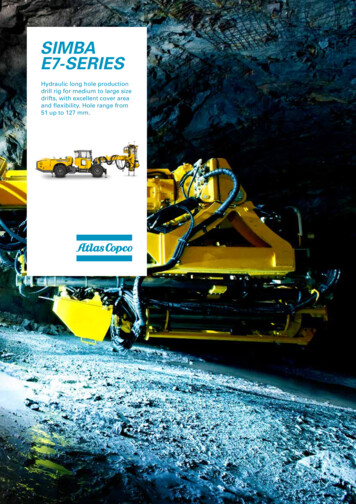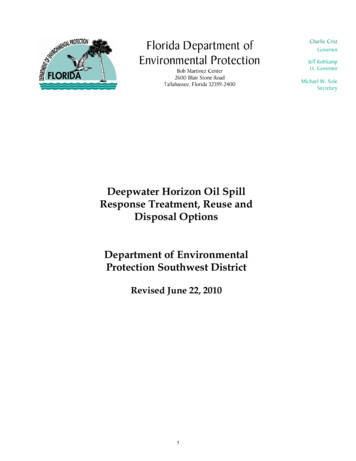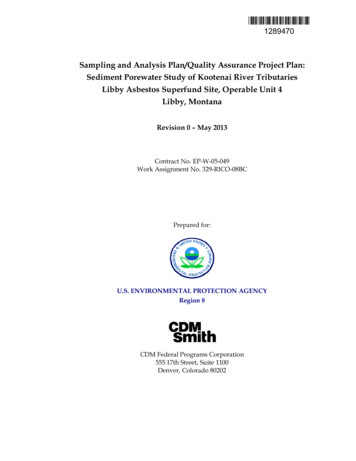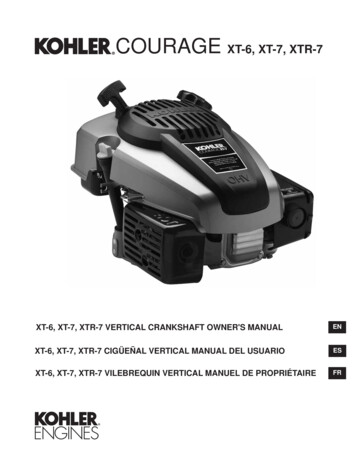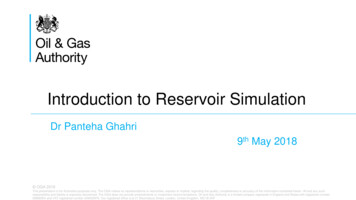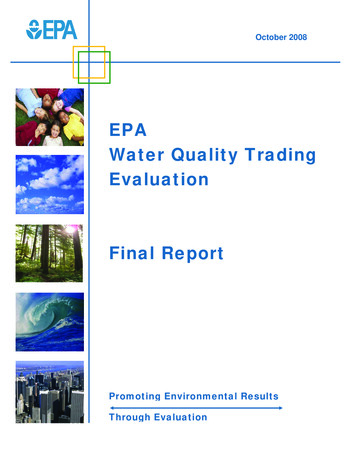
Transcription
Mechanical ContainmentAnd Recovery of OilFollowing A Spill2INTRODUCTIONTWO MAJOR STEPS involved in controlling oil spills arecontainment and recovery. This chapter outlines some ofthe techniques and equipment that are used to conduct oilspill control efforts. A “longitudinal support,” usually a chain or cablerunning along the bottom of the skirt, that strengthensthe boom against wind and wave action; may also serveas a weight or ballast to add stability and help keep theboom uprightCONTAINMENTBooms can be divided into several basic types. Fencebooms have a high freeboard and a flat flotation device,making them least effective in rough water, where waveand wind action can cause the boom to twist. Round or“curtain” booms have a more circular flotation device anda continuous skirt. They perform well in rough water, butare more difficult to clean and store than fence booms.Non-rigid inflatable booms come in many shapes. They areeasy to clean and store, and they perform well in roughseas. However, they tend to be expensive, morecomplicated to use, and puncture and deflate easily. Allboom types are greatly affected by the conditions at sea;the higher the waves swell, the less effective boomsbecome.WHEN AN OIL SPILL occurs on water, it is critical tocontain the spill as quickly as possible in order to minimizedanger and potential damage to persons, property, andnatural resources. Containment equipment is used torestrict the spread of oil and to allow for its recovery,removal, or dispersal. The most common type ofequipment used to control the spread of oil is floatingbarriers, called booms.BoomsContainment booms are used to control the spread of oil toreduce the possibility of polluting shorelines and otherresources, as well as to concentrate oil in thicker surfacelayers, making recovery easier. In addition, booms may beused to divert and channel oil slicks along desired paths,making them easier to remove from the surface of thewater.Booms can be used to control the spread of oil.Although there is a great deal of variation in the designand construction of booms, all generally share four basiccharacteristics: An above-water “freeboard” to contain the oil and tohelp prevent waves from splashing oil over the top ofthe boom A flotation device A below-water skirt to contain the oil and help reducethe amount of oil lost under the boomEPA Office of Emergency and Remedial Response 9
It is necessary for stationary booms to be monitored ortended due to changes produced by shifting tides, tidalcurrents, winds, or other factors that influence water depthand direction and force of motion. People must tendbooms around the clock to monitor and adjust theequipment.The forces exerted by currents, waves, and wind mayimpair the ability of a boom to hold oil. Loss of oiloccurring when friction between the water and oil causesdroplets of oil to separate from the slick and be pulledunder the boom is called entrainment. Currents or towspeeds greater than three-quarters of a knot may causeentrainment. Wind and waves can force oil over the top ofthe boom’s freeboard or even flatten the boom into thewater, causing it to release the contained oil. Mechanicalproblems and improper mooring can also cause a boom tofail.While most booms perform well in gentle seas withsmooth, long waves, rough and choppy water is likely tocontribute to boom failure. ln some circumstances,lengthening a boom’s skirt or freeboard can help to containthe oil. Because they have more resistance to natural forcessuch as wind, waves, and currents, oversized booms aremore prone to failure or leakage than smaller ones.Generally, booms will not operate properly when wavesare higher than one meter or currents are moving fasterthan one knot per hour. However, new technologies, suchas submergence plane booms and entrainment inhibitors,are being developed that will allow booms to operate athigher speeds while retaining more oil.RECOVERY OF OILONCE AN OIL SPILL has been contained, efforts toremove the oil from the water can begin. Three differenttypes of equipment—booms, skimmers, and sorbents—arecommonly used to recover oil from the surface.BoomsWhen used in recovering oil, booms are often supportedby a horizontal arm extending directly off one or bothsides of a vessel. Sailing through the heaviest sections ofthe spill at low speeds, a vessel scoops the oil and traps itbetween the angle of the boom and the vessel’s hull. lnanother variation, a boom is moored at the end points of arigid arm extended from the vessel, forming a ”U”- or “J” shaped pocket in which oil can collect. In either case, thetrapped oil can then be pumped out to holding tanks andreturned to shore for proper disposal or recycling.SkimmersA skimmer is a device for recovery of spilled oil from thewater’s surface. Skimmers may be self-propelled and maybe used from shore or operated from vessels. The efficiencyof skimmers depends on weather conditions. Inmoderately rough or choppy water, skimmers tend toPhoto courtesy of RO-CLEAN DESMIBooms can be fixed to a structure, such as a pier or a buoy,or towed behind or alongside one or more vessels. Whenstationary or moored, the boom is anchored below thewater surface.Other Barriers: Improvised BoomsWhen a spill occurs and no containment equipment isavailable, barriers can be improvised from whatevermaterials are at hand. Although they are most often usedas temporary measures to hold or divert oil until moresophisticated equipment arrives, improvised booms can bean effective way to deal with oil spills, particularly in calmwater such as streams, slow-moving rivers, or shelteredbays and inlets.Oleophilic skimmer.Photo courtesy of RO-CLEAN DESMIImprovised booms are made from such common materialsas wood, plastic pipe, inflated fire hoses, automobile tires,and empty oil drums. They can be as simple as a boardplaced across the surface of a slow-moving stream, or aberm built by bulldozers pushing a wall of sand out fromthe beach to divert oil from a sensitive section of shoreline.Suction skimmer.10 Understanding Oil Spills and Oil Spill Response
Weir skimmers use a dam or enclosure positioned at theoil/water interface. Oil floating on top of the water willspill over the dam and be trapped in a well inside,bringing with it as little water as possible, The trapped oiland water mixture can then be pumped out through a pipeor hose to a storage tank for recycling or disposal. Theseskimmers are prone to becoming jammed and clogged byfloating debris.Oleophilic (oil-attracting) skimmers use belts, disks, orcontinuous mop chains of oleophilic materials to blot theoil from the water surface. The oil is then squeezed out orscraped off into a recovery tank. Oleophilic skimmers havethe advantage of flexibility, allowing them to be usedeffectively on spills of any thickness. Some types, such aschain or “rope-mop” skimmers, work well on water that ischoked with debris or rough ice.A suction skimmer operates like a household vacuumcleaner. Oil is sucked up through wide floating heads andpumped into storage tanks. Although suction skimmersare generally very efficient, they are vulnerable tobecoming clogged by debris and require constant skilledobservation. Suction skimmers operate best on smoothwater where oil has collected against a boom or barrier.SorbentsSorbents are materials that soak up liquids. They can beused to recover oil through the mechanisms of absorption,adsorption, or both. Absorbents allow oil to penetrate intopore spaces in the material they are made of, whileadsorbents attract oil to their surfaces but do not allow it topenetrate into the material. To be useful in combating oilspills, sorbents need to be both oleophilic and hydrophobic(water-repellant). Although they may be used as the solecleanup method in small spills, sorbents are most oftenused to remove final traces of oil, or in areas that cannot bereached by skimmers. Once sorbents have been used torecover oil, they must be removed from the water andproperly disposed of on land or cleaned for re-use. Any oilthat is removed from sorbent materials must also beproperly disposed of or recycled.Sorbents can be divided into three basic categories: naturalorganic, natural inorganic, and synthetic. Natural organicsorbents include peat moss, straw, hay, sawdust, groundcorncobs, feathers, and other carbon-based products. Theyare relatively inexpensive and usually readily available.Organic sorbents can soak up from 3 to 15 times theirweight in oil, but they do present some disadvantages.Some organic sorbents tend to soak up water as well as oil,causing them to sink. Many organic sorbents are looseEPA Office of Emergency and Remedial Response Photo courtesy of US Coast Guardrecover more water than oil. Three types of skimmers—weir, oleophilic, and suction—are described below. Each typeoffers advantages and drawbacks, depending on the typeof oil being cleaned up, the conditions of the sea duringcleanup efforts, and the presence of ice or debris in thewater.Application of sorbents.particles, such as sawdust, and are difficult to collect afterthey are spread on the water. Adding flotation devices,such as empty drums attached to sorbent bales of hay, canhelp to overcome the sinking problem, and wrapping looseparticles in mesh will aid in collection.Natural inorganic sorbents include clay, perlite,vermiculite, glass, wool, sand, and volcanic ash. They canabsorb from 4 to 20 times their weight in oil. Inorganicsubstances, like organic substances, are inexpensive andreadily available in large quantities.Synthetic sorbents include man-made materials that aresimilar to plastics, such as polyurethane, polyethylene, andnylon fibers. Most synthetic sorbents can absorb as muchas 70 times their weight in oil, and some types can becleaned and reused several times. Synthetic sorbents thatcannot be cleaned after they are used can presentdifficulties because they must be stored temporarily untilthey can be disposed of properly.The following characteristics must be considered whenchoosing sorbents for cleaning up spills: Rate of absorption—The rate of absorption varies withthe thickness of the oil. Light oils are soaked up morequickly than heavy ones. Oil retention—The weight of recovered oil can cause asorbent structure to sag and deform. When it is liftedout of the water, it can release oil that is trapped in itspores. During recovery of absorbent materials, lighter,less viscous oil is lost through the pores more easilythan heavier, more viscous oil. Ease of application—Sorbents may be applied to spillsmanually or mechanically, using blowers or fans. Manynatural organic sorbents that exist as loose materials,such as clay and vermiculite, are dusty, difficult to applyin windy conditions, and potentially hazardous ifinhaled.11
SUMMARYTHE PRIMARY tools used to respond to oil spills aremechanical containment, recovery, and cleanupequipment. Such equipment includes a variety of booms,barriers, and skimmers, as well as natural and syntheticsorbent materials. A key to effectively combating spilled oilis careful selection and proper use of the equipment andmaterials most suited to the type of oil and the conditionsat the spill site. Most spill response equipment andmaterials are greatly affected by such factors as conditionsat sea, water currents, and wind. Damage to spillcontaminated shorelines and dangers to other threatenedareas can be reduced by timely and proper use ofcontainment and recovery equipment.CLEANING UP AN OIL SPILL:AN EXPERIMENT YOU CAN DO AT HOMETHIS EXPERIMENT is designed to help you tounderstand the difficulties with oil spill cleanups. Youwill need the following equipment: two aluminum pie pans, each half-filled with water a medicine dropper full of used motor oil cotton balls (use real cotton) nylon string paper towels liquid detergent feathersBefore you begin, make a list of predictions about theaction of oil and water. You might want to answer thefollowing questions in your list: What will happen to the oil when you drop it on thewater? Will it sink, float, or mix in? Which material will clean up the oil in the leastamount of time? Cotton, nylon, paper towel, orstring? How might wind and waves affect the combinationof oil and water?Complete each of the following steps, and observewhat happens.1. Put five drops of motor oil into one of the “oceans”(your aluminum pie pans). Observe the action ofthe oil, and record what happens. Was yourprediction correct?2. One at a time, use the different materials (nylon,cotton, string, and paper towels) to try to clean upthe oil from the water, keeping track of the amountof oil each material was able to clean up and howfast it worked. (These materials are what booms andskimmers are made of.) Which cleaned up the oilthe fastest? The best?3. Add five drops of oil to the second pan. Add fivedrops of liquid detergent. (This represents thechemical dispersants.) Observe what happens.Where do you think the oil would go in the “real”oceans?4. Dip a feather directly into some oil. What happensto it? How do you think this might affect a bird’sbehaviors, such as flying, preening, and feeding?Used with permission from Jane O. Howard, “Slick Science,”Science and Children, vol. 27, no. 2 (October 1989).12 Understanding Oil Spills and Oil Spill Response
the beach to divert oil from a sensitive section of shor eline. RECOVERY OF OIL ONCE AN OIL SPILL has been contained, efforts to remove the oil from the water can begin. Three different types of equipment— booms, skimmers, and sorbents—are commonly used to recover oil from the surface. Booms When used in recovering oil, booms are often .



